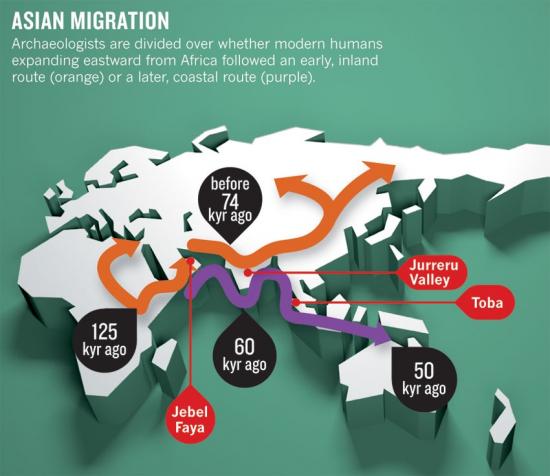Human migrations: Eastern odyssey
Humans had spread across Asia by 50,000 years ago. Everything else about our original exodus from Africa is up for debate.
Tim Appenzeller
Source - http://www.nature.com/news/human-migrations-eastern-odyssey-1.10560

The Andaman Islands: a stop for migrants 'beach-hopping' around Asia? - O. BLAISE/GETTY
One day some 74,000 years ago, in a swampy valley in the south of India, dawn never came. In the half-light, greyish dust sifted down, blanketing the ground and turning trees to ghosts. Far to the east, a volcano called Toba on the Indonesian island of Sumatra had unleashed one of the greatest eruptions ever known, flinging thousands of cubic kilometres of rock into the atmosphere and spreading a pall of ash across southern Asia.
Clive Oppenheimer, a volcanologist at the University of Cambridge, UK, has studied the ash deposits in India's Jurreru Valley to reconstruct the events that followed. Within days, the trees shed their whitened foliage; rains later swept ash into layers several metres thick on the valley floor. Eventually, the lakes and swamps vanished, perhaps because the climate had
The catastrophe had witnesses. Archaeologists digging beneath the ash layer have found stone artefacts indicating that humans were living in the valley before the eruption. But were they modern humans — people like us — or some other, now extinct, branch of the human lineage?
Today, the thick ash deposits of the Jurreru Valley mark a division not only in the geological record but also between archaeologists debating one of the field's biggest questions: when and how did modern humans leave their African cradle and colonize Asia, Earth's largest landmass? It was the first great expansion of the human species, carrying people some 12,000 kilometres to Australia by about 50,000 years ago. But just how early the pioneers set out is controversial — as are the routes they followed, the tools they carried and, most fundamental of all, what triggered the migration. Were they enticed into the wider world by a favourable climate, or propelled by a revolution in technology and culture?
In archaeologists' shorthand, the debate boils down to a simple question: pre-Toba or post-Toba? At one pole of the debate, Paul Mellars at the University of Cambridge argues passionately that modern humans left Africa long after the Toba eruption, 60,000 years ago at the earliest. Equipped with new technologies, including bows and arrows, they beach-hopped along the coastline of the Arabian peninsula, India and southeast Asia, reaching Australia in short order. Genetic analyses of contemporary Asians that point to a late, rapid colonization have bolstered his confidence. “I'm more convinced than ever that I'm right,” he says, before adding, “I guess they all say that.”

Expand
His opposite number, Michael Petraglia at the University of Oxford, UK, certainly does. He is convinced that people spread into Asia at least 74,000 years ago, and perhaps as early as 125,000 years ago, well before Toba, during a wet, warm interlude between ice ages, carrying tools no more sophisticated than those made by earlier humans. Rather than following the coast, he thinks they wandered along river valleys and lake shores, advancing and retreating as the environment allowed, more like wildlife than a wave of colonists. He takes heart from discoveries that testify to the presence of modern humans in the Arabian Peninsula, on the very doorstep of Asia, more than 100,000 years ago. “I'm feeling more and more confident through time,” he says.
It is a full-throated academic duel. Petraglia calls Mellars' view “baseless archaeologically”; Mellars vows to “demolish the pre-Toba model”. Their passion is fuelled both by the prize of understanding the first great human migration — and by the lack of decisive evidence. That leaves many other archaeologists in the same position as Chris Stringer of London's Natural History Museum, who says he is “sitting on the fence” until researchers unearth more data. The wait may not be long. Archaeologists are busily hunting for artefacts and even fossils of the first modern Asians, which could finally put the debate to rest.
PART. 2